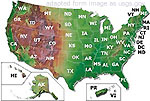Russia’s Misery Loves U.S. Company

(Moscow Times – themoscowtimes.com – Michael Bohm – Nov. 30, 2012 – Michael Bohm is opinion page editor of The Moscow Times)
For many Russian conservatives who still mourn the collapse of the Soviet Union, the “secession” movement in the U.S. has offered some misguided comfort, if not schadenfreude.
After the Nov. 6 U.S. presidential election, more than 500,000 Republicans, Tea Party members and other opponents of President Barack Obama signed online petitions in nearly all states saying they would like their states to secede in protest of four more years of Obama. Although the so-called secessionist movement is a creative and provocative form of protest, nobody in the U.S. is taking it seriously as a threat to the country’s territorial integrity and it certainly shouldn’t be taken seriously in Russia.
Yet many Russians got excited about what they believe are serious cracks in the U.S. federal republic. Prominent television journalist Maxim Shevchenko told Newsland.ru that Russia should give grants to the U.S. “separatists” to help develop human rights in the U.S. What’s more, “the leaders of the movement can become leading experts on Russia Today [state-controlled television],” he added.
Shevchenko is not the only public figure to lend support to U.S. separatism. In 2008, Igor Panarin, a former KGB analyst and author of the book “The Crash of the Dollar and the Disintegration of the USA,” famously predicted that the U.S. would collapse into six parts by summer 2010. He instantly became a darling of the Kremlin-friendly media, giving several interviews a day for weeks on end. Panarin predicted that after the U.S. collapses, Russia will not only grab Alaska back, it will finally regain its status as a superpower.
Of course, there is one huge problem with this wishful thinking: How will Russia come out ahead if the U.S. splits into six parts and the dollar crashes particularly when the Central Bank holds 45 percent of its foreign currency reserves, or more than $225 billion, in U.S. dollars? Clearly, if the U.S. disintegrates, Russia will follow, along with the entire global economy.
In the end, of course, Panarin’s apocalyptic 2010 deadline came and went, while America’s 50 united states still stand. Far from losing states to separatism, we are actually seeing the opposite trend. For example, Puerto Rico, which holds the vague status of a U.S. territory, held a referendum on Nov. 6 in which 61 percent of residents who are U.S. citizens said they would like to become the 51st state.
In reality, there is no mechanism in the U.S. Constitution for a state to secede from the Union. When South Carolina and 10 other states tried to secede in 1860 and 1861, President Abraham Lincoln sent federal troops into the Confederacy. After four years of civil war and the deaths of more than 600,000 Americans, the U.S. restored its territorial integrity in 1865.
Even those who have signed the secession petitions concede that opposition to Obama is hardly a reason to spark another civil war. After all, they know that this is Obama’s last term in office, as stipulated by the Constitution. In four years, there will be another U.S. presidential election, which will allow for a peaceful change of regime and the opportunity to introduce a new political course. This important feature of U.S. democracy may be lost on Russians who are jaded by their own country’s pseudo elections, castling between a ruling tandem and a de facto president for life.
In contrast, the Soviet Union did have a mechanism for secession: Article 72 of the 1977 Soviet Constitution, which gave every republic the right to peacefully secede. Of course, since the Kremlin thought the Soviet Union was “indissoluble,” as the Soviet national anthem boldly stated in its opening line, Article 72 was a purely decorative, democratic-sounding provision in the Constitution. But the article played a cruel joke on the hard-line Communist leaders in 1991, when all 15 Soviet republics including the Russian Republic cited Article 72 as their legal pretext to secede from the Soviet Union, which they did, one after another, from September to December 1991.
Meanwhile, Alexander Oskin, chairman of the Press Distributors’ Association, a Moscow-based trade group for publishers and the mass media, told Vzglyad.ru that the online petition movement is the first massive separatist movement in the U.S. since the Civil War. Oskin also believes that the U.S. will collapse in the same way that the Soviet Union and Yugoslavia did.
Similarly, Panarin and other pro-Kremlin analysts believe that when the U.S. collapses, it will be no less painful than the Soviet collapse in 1991. This sentiment is shared by many Russians in the blogosphere. For example, blogger Alexander Petrovich wrote, “I want to watch if Americans will be able to survive what we experienced in the ’90s.” Blogger Cory wrote: “I was glad to learn of the petition movement in the U.S. Once their problems start, maybe they will stop meddling in our affairs.”
Earlier, some Russians indulged themselves in predictions that New York City would be completely destroyed after sinking into the ocean. Now they are taking delight in the fact that U.S. “separatists” may force the country to fall apart.
These sentiments reveal a distorted psyche. After the Soviet collapse, the argument goes, at least we can take comfort in the fact that the Americans, too, will experience the same tragedy.
They say misery loves company, but this may be taking schadenfreude a bit too far.
